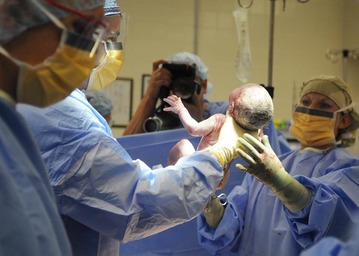 Full disclosure: all of my colleagues refused to write a blog post on this topic. “Ewww,” one said. “I don’t feel comfortable writing about that,” said another. Even when I pointed out that our department has written papers on very similar topics, they all declined. So I decided to tackle it myself, because a) it’s a topic that applies to everyone who was ever born, b) is biologically very important and interesting, and c), I think it’s an excellent example of how the implications of a small but interesting scientific study can be misinterpreted, exaggerated, or distorted. In a paper published in Nature Medicine on February 1st, researchers at the University of Puerto Rico reported on a study of 18 babies, 11 born by elective Cesarian section and 7 born vaginally. A few minutes after being born, 4 of the c-section babies were swabbed all over with a sterile piece of gauze containing their mothers’ vaginal fluids, a practice dubbed “vaginal seeding”. The idea was to mimic the experience of vaginal birth, in which infants are exposed to a wide variety of bacteria as they travel through their mother’s birth canal. Most researchers now believe that this initial bacterial exposure helps build the infants’ colony of gut bacteria, also known as the microbiome. Deficiencies in the microbiome have been linked to obesity, metabolic disorders and other health problems.
The findings of this study were straightforward and compelling: – the four c-section babies who were swabbed had similar populations of bacteria to the seven babies who had been born vaginally. The microbiomes of the seven c-section babies who were not swabbed were different. The study was also full of caveats. This was a tiny study of 18 babies, all born in the same hospital. All of the c-sections were planned, not emergency procedures. Women with contagious diseases like Group B strep, which affects roughly 25 percent of all U.S. women and can be transmitted to babies during birth, were excluded from the study. And there was no evidence to suggest that the differences in the babies’ bacteria would last, or have any long-term – or beneficial – health effects. In short, it was too soon to suggest that every woman giving birth by c-section consider this procedure. Yet that’s exactly what happened. The New York Times headlined its article with “Using a Mother’s Microbes to Protect Cesarean Babies”, suggesting that babies without such microbes were unprotected. The Scientist titled its article “Restoring C-Section Babies’ Microbiota”, which again implies that babies born by c-section are in need of “restoration.” “Boost C-section babies by giving them vaginal bacteria”, the New Scientist declared in its headline, which implies that babies should be swabbed with vaginal bacteria and that babies who are not are at a disadvantage. In fairness to these journalists, the articles accompanying these headlines did mention the limitations of the study -- eventually. But a quick or casual reader could easily be given the impression that vaginal seeding of c-section babies was not only recommended, but necessary. And the pendulum can just as easily swing in the opposite direction. After three doctors published an editorial in the British Medical Journal on February 23rd, warning that vaginal seeding could expose babies to Group B strep and other pathogens, there was a flurry of articles warning of these and other risks. And so, in a little more than three weeks’ time, a small study with limited, preliminary findings was treated both as the “cure” for c-section babies and as an active threat to their health. This makes this study another sort of cautionary tale – one on science, the media, and rushing to conclusions.
0 Comments
Your comment will be posted after it is approved.
Leave a Reply. |
©2017 WeighingInBlog. All rights reserved. 401 Park Drive, Boston, MA




 RSS Feed
RSS Feed

